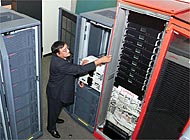
Swiss scientists build cheaper supercomputer

Swiss scientists are working to design a cheaper supercomputer. On Wednesday, they unveiled a prototype of a new system which they hope will eventually offer the same performance as traditional models, but at one-fifth of the cost.
Supercomputers have traditionally been powerful machines that lurk in computing centres, and carry out tasks according to demand. Customers supply applications that only the number-crunching capacities and speed of a supercomputer can handle.
The main drawback is cost – supercomputers are very expensive to run, and the cost of developing more powerful machines can be prohibitive.
A group of scientists from Lausanne’s Federal Institute of Technology, along with researchers from America’s Sandia and Oak Ridge National Laboratories, has been working to develop a cheaper version. Their approach is to use off-the-shelf components from a manufacturer, as well as standard software to build a parallel supercomputer.
The latest result of this research is the Swiss-T1 parallel supercomputer. While this was only one stage of the project, it was also the make-or-break point. If the machine had not satisfied an outside evaluation, the project would have been shut down.
The computer is in fact a collection, or cluster, of machines that are connected by a network with the appropriate hardware and software. In theory, any number of machines can be connected to the network, increasing computing power as needed. Its makers say the machine also offers greater reliability and hardware flexibility because it uses tried and tested components.
The chief disadvantage of this system is that it can only run one application. This is because the computer is customised for the application, rather than the other way round, which is the case with more traditional systems.
The limitation of being able to run just one application is what keeps the price down, according to Ralf Gruber, who is project manager for the Swiss-Tx supercomputer project.
He says the price of the final system (Swiss-T2) should be only SFr2 million ($1.1 million), which is about one-fifth of the cost of other systems. This gives the Lausanne group’s design a major price advantage.
A number of potential applications for the new machine are being considered, among them fabric cutting or gene sequencing.
The machine’s designers have also not forgotten the importance of marketing. A company is to be launched next month with the sole aim of promoting the Swiss-Tx concept.
by Scott Capper

In compliance with the JTI standards
More: SWI swissinfo.ch certified by the Journalism Trust Initiative




























You can find an overview of ongoing debates with our journalists here . Please join us!
If you want to start a conversation about a topic raised in this article or want to report factual errors, email us at english@swissinfo.ch.